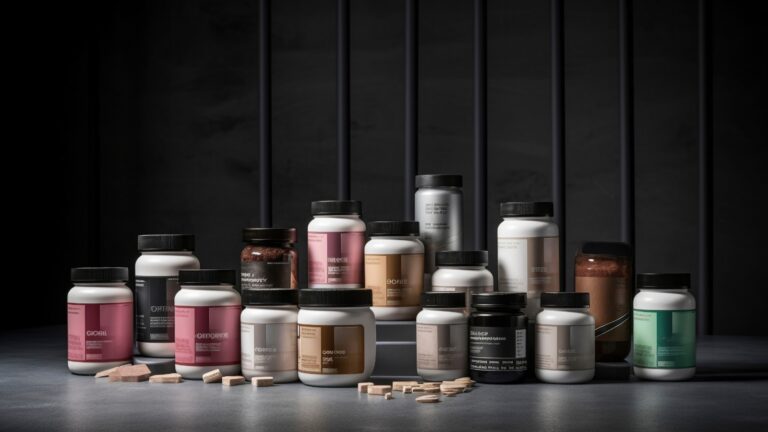Running has long been considered a go-to exercise for fitness enthusiasts and competitive athletes alike. Known for its cardiovascular benefits and the “runner’s high” often experienced, one may wonder whether running also has an impact on testosterone levels.
Testosterone, a hormone produced primarily in the testicles, plays a role in building muscle mass and strength, maintaining bone density, and regulating sexual function.
So does running increase testosterone? We look at the science, the studies and our own personal experiences to try and answer this question.

Research on the relationship between running and testosterone levels has yielded mixed results. Some studies have shown that intense long-term running can lead to significant increases in testosterone, while others have found little to no change.
Various factors, such as the intensity and duration of the exercise, may contribute to these discrepancies. It is essential to explore the potential correlation between running and testosterone, and how individuals can maintain a healthy balance, given the vital hormone’s myriad of functions.
Key Takeaways
- Running may impact testosterone levels, although the relationship is not entirely clear
- Factors such as exercise intensity and duration can influence the effect of running on testosterone
- A balanced approach to exercise and lifestyle may help maintain optimal testosterone levels.
Understanding the Correlation Between Running and Testosterone
The Physiology Behind Running and Testosterone
As a fitness enthusiast, I have always been curious about the effects of exercise on our bodies, particularly the relationship between exercise and testosterone levels. Testosterone, primarily thought of as the male sex hormone, plays a crucial role in both men and women’s muscular development, bone strength, and overall physical performance.
Running, like other endurance sports, requires a significant amount of energy and impacts various physiological systems in our bodies. During exercise, the body undergoes several hormonal changes that help in adapting to the increased energy demands. One such alteration involves the release of testosterone. Studies have shown that both acute and long-term endurance training can affect testosterone levels in men and women differently[^1^].
Running and Hormone Levels
When I run, it’s essential to understand how it could impact my hormone levels. Testosterone is responsible for supporting muscle growth and strength, promoting overall well-being, and enhancing athletic performance. It is natural to assume that exercise, especially running, would lead to an increase in this crucial hormone.
However, there isn’t a straightforward relationship between running and testosterone levels. While it’s true that testosterone levels may increase mildly immediately after intense or short-duration runs, chronic endurance training might lead to a decrease in resting testosterone levels[^2^]. This decrease in testosterone levels has been observed more in men than in women[^3^].
Interestingly, the impact of running on testosterone levels might also be influenced by the intensity and duration of the run. It has been noted that high-intensity interval training can boost testosterone levels more effectively than regular endurance training[^4^].
In conclusion, it is crucial to acknowledge that running can impact testosterone levels differently in individuals, depending on factors such as sex, the intensity of the run, and the duration of the exercise. Finding the right balance between intensity, duration, and recovery can help maintain optimal testosterone levels for both men and women.
[^1^] Influence of female sex hormones on ultra- running performance and post-race recovery: role of testosterone [^2^] Testosterone levels in healthy men and the relation to behavioural and physical characteristics: facts and constructs [^3^] Is testosterone responsible for athletic success in female athletes? [^4^] Is testosterone influencing explosive performance?
How Different Factors Increase Testosterone Levels

As we dive deeper into understanding the relationship between running and testosterone, it’s crucial to consider the various factors that impact our hormone levels. In this section, I’ll explore three key areas: age and sex, diet and lifestyle, and the types of exercises we engage in.
Effect of Age and Sex
When it comes to testosterone, age plays a significant role. As I get older, my testosterone levels naturally decline. This decline usually starts from the age of 30 and continues to decline steadily over the years. Likewise, differences in sex can impact testosterone levels. Men typically have higher testosterone levels due to the hormone’s essential role in male sexual development and function.
Influence of Diet and Lifestyle
The foods I consume and my overall lifestyle can also have a substantial impact on my testosterone levels. Consuming a balanced diet rich in healthy fats, vitamins, and minerals is vital for maintaining optimal hormone levels. Choosing a diet high in processed foods, excessive sugar, and unhealthy fats can lead to lower testosterone levels.
Furthermore, getting sufficient sleep, managing stress, and staying within a healthy weight range are vital factors for maintaining balanced testosterone levels. Elevated cortisol (a stress hormone) levels, for instance, can inhibit testosterone production. In men, carrying extra body fat can convert testosterone to estrogen, thereby reducing its availability in the body.
Impact of Exercise Type
When it comes to exercise, different types can have varying effects on our testosterone levels. Generally speaking, resistance training, such as weightlifting, can support testosterone production. Particularly, I would want to focus on compound movements that engage multiple muscle groups, like squats, deadlifts, and bench presses.
Cardiovascular exercises like running can also have an impact on testosterone levels, depending on the intensity and duration of the workouts. Long-distance running, for example, might lead to lower testosterone levels if not balanced with an appropriate recovery period. In this case, including short bouts of high-intensity interval training (HIIT) can amplify testosterone production more effectively.
In conclusion, numerous factors influence testosterone levels, including age, sex, diet, lifestyle, and the type of exercise. Keeping in mind these factors can help maintain optimal hormone levels and potentially reap the benefits of higher testosterone for improved performance, mood, and well-being.
The Counterpoint: Possible Negative Effects of Running on Testosterone

Understanding Cortisol: The Stress Hormone
While running and regular exercise can indeed have a positive impact on testosterone levels, it’s essential to understand the delicate balance between exercise and hormone levels in the body. One critical hormone to consider is cortisol, also known as the stress hormone. When I engage in intense exercise, cortisol levels increase in response to the physical stress placed on my body. Prolonged elevated cortisol levels may result in suppression of testosterone production.
It is crucial to find a balance in training to maintain healthy cortisol and testosterone levels. Over time, consistently high cortisol levels can lead to fatigue, weakening of the immune system, and increased mental-stress, which are all factors that may indirectly affect testosterone levels.
Running and Overtraining
Moreover, overtraining as a result of excessive running can have detrimental effects on my testosterone levels and overall mental health. When I push my body beyond its limits without adequate recovery, it may lead to overtraining syndrome, characterised by persistently elevated cortisol levels, low testosterone, and stress fractures.
Overtraining can have wide-ranging consequences not only on physical health but mental well-being as well. Symptoms of overtraining include chronic fatigue, sleep disturbances, and mood swings. As testosterone is closely linked to mood regulation, mental health, and energy, these symptoms may exacerbate the negative effects of low testosterone.
To maintain a balance between the benefits and potential negative impacts of running on testosterone levels, it is crucial for me to listen to my body, ensure adequate recovery, and not push too hard or too often. Finding the right balance can help keep cortisol and testosterone levels in check, promoting overall health and well-being.
Maintaining Balanced Testosterone Levels
Role of Strength Training
In my experience, incorporating strength training into my exercise routine has contributed to maintaining balanced testosterone levels. Lifting weights, particularly free weights, and engaging in sprinting have been beneficial for increasing testosterone. Weight training, including high-intensity exercises and compound movements, such as squats and deadlifts, can help improve muscle development and stimulate testosterone production.
Importance of Recovery and Sleep
I’ve noticed that besides exercise, recovery and sleep play a crucial role in maintaining healthy testosterone levels. Adequate sleep, particularly getting 7 to 8 hours a night, helps in regulating hormone balance and encourages muscle repair. Sleep quality also affects testosterone production, so creating a suitable sleep environment and sticking to a consistent sleep schedule is important for overall hormonal balance.
Testosterone Boosting Supplements
To further support balanced testosterone levels, I’ve incorporated certain supplements into my routine. By consuming adequate protein, either through diet or using protein supplements, I’ve been able to improve muscle growth and increase testosterone. Omega-3 fatty acids, found in fish oil supplements, are also beneficial for hormone balance. I’ve found it essential to ensure sufficient intake of vitamins and minerals, such as vitamin D and zinc, as these nutrients are known to support testosterone production.
When considering supplements, it’s worth noting the difference between natural testosterone boosters and steroids. While some supplements, like the ones I’ve mentioned, help promote testosterone production, using anabolic steroids can have harmful side effects and is illegal in most sports. It’s crucial to choose supplements wisely and always consult a healthcare professional before starting any new supplement regimen.







